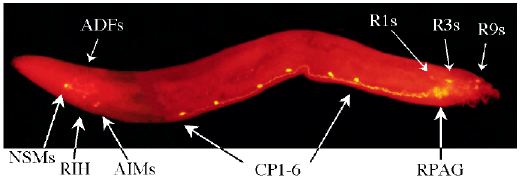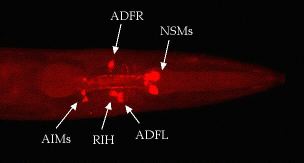
Adult male C. elegans. Anterior to the left, dorsal up. Click image for a larger version.

Serotonin cells in the head (hermaphrodite; same in the male). Anterior to the right; ventral (slightly lateral) view. Click image for a larger version.
Schematic of Serotonin-containing [serotonin immunoreactive] cells in hermaphrodite and male
RIH - unpaired interneuron, soma located ventral to isthmus of pharynx. Found in both hermaphrodite and male. (RIH = AB.prpappaaa)
ADFs - amphid sensory neurons, ADF Right & Left (bilaterally symmetric), somas located ventrolaterally. Each extends a process into the nerve ring and a dendrite to the tip of the nose with each amphid (sensory structure containing endings of many sensory neurons). Found in both hermaphrodite and male. (ADFR = AB.praaappaa; ADFL = AB.alpppppaa)
AIMs - interneuron, AIM Right & Left (bilaterally symmetric), somas located near ventral midline below posterior bulb of pharynx. Found in both hermaphrodite and male. (AIMR = AB.prpaapppa; AIML = AB.plpaapppa)
CP1-6 - six unpaired ventral nerve cord (VNC) probable motor neurons, extending processes posteriorly in VNC, connecting to male diagonal muscles. Lineage designation P3-8.aapp (i.e., CP1 is P3.aapp). There are other non-serotonergic CP neurons in the VNC (CP0, CP7-9). Male-specific.
RPAG - "Right preanal ganglion neuron" - unpaired cell, precise identity unknown but likely to be either PDC (P11.papa) or PGA (P11.papp). Male-specific.
R1Bs, R3Bs, R9Bs - six ray sensory neurons associated with rays 1, 3 and 9 (right & left - bilaterally symmetric); Both R9B somas are visible in male figure. Male-specific. [Jia and Emmons (2000) recently determined that these were the 'B' type ray neurons; see reference (unpublished) below.]
Not indicated: CA1-4 - four unpaired VNC probable motor neurons, staining weak and unreliable with anti-serotonin, P3-6.aapa (sister cells to CP1-4). Male-specific.
Not indicated: HSNs - "Hermaphrodite-specific neuron," HSN Right & Left (bilaterally symmetric), somas located sublaterally just posterior to vulva in hermaphrodite, innervate vulval muscles and extend process anteriorly to nerve ring. Egg-laying neuron. (HSNR = AB.prapppappa; HSNL = AB.plapppappa)
Not indicated: VC4, VC5 - two unpaired neurons in VNC, somas just anterior (VC4 = P6.aap) or posterior (VC5 = P7.aap) to the vulva, staining weak and unreliable with anti-serotonin, innervate vulval muscles. Hermaphrodite-specific.
Other neurons reported to be serotonin-containing (Sawin et al., 2000):
PHB's, I5
Horvitz H, Chalfie M, Trent C, Sulston J, Evans P (1982) Serotonin and octopamine in the nematode C. elegans. Science 216:1012-1014.
Jia L, Emmons SW (2000) Ray neuron targeting in the male tail. East Coast Worm Meeting Abstracts (unpublished) #111.
Loer CM, Kenyon CJ (1993) Serotonin-deficient mutants and male mating behavior in the nematode C. elegans. J. Neurosci., 13:5407-5418.
Rand JB, Nonet ML (1997) Neurotransmitter assignments for specific neurons. In: C. elegans II (Riddle, Blumenthal, Meyer & Priess, editors) pp 1049-1052. Cold Spring Harbor Laboratory Press, Cold Spring Harbor Laboratory, NY. (Neurotransmitter assignments table)
Sawin ER, Ranganathan R, Horvitz HR (2000) C. elegans locomotory rate is modulated by the environment through a dopaminergic pathway and by experience through a serotonergic pathway. Neuron 26:619-631.
Sulston J, White J (1988) Parts List. In: The Nematode Caenorhabditis elegans (W. B. Wood, ed), pp 415-431. Cold Spring Harbor,
New York: Cold Spring Harbor Laboratory.